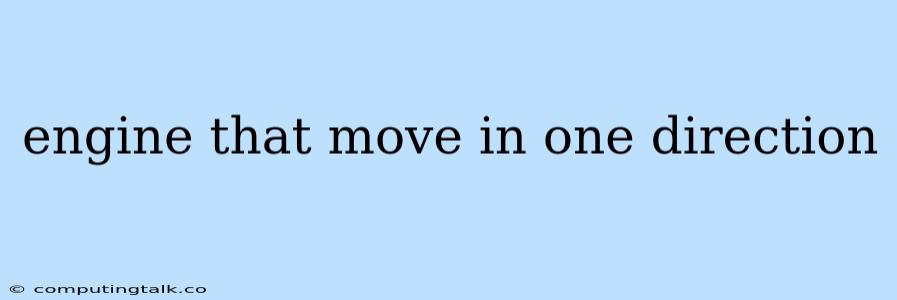Imagine a machine that can move in only one direction. This might seem limiting at first, but it opens a world of possibilities in engineering and design. From simple mechanisms to complex systems, engines that move in one direction are crucial for various applications.
Understanding the Concept
A one-directional engine is designed to produce motion in a specific direction. This means the engine's output shaft rotates in a single direction, unlike a standard engine that can rotate both clockwise and counterclockwise.
Types of One-Directional Engines
One-directional engines can be categorized based on their design and application:
- Reciprocating Engines: These engines use a piston that moves back and forth in a cylinder, converting linear motion into rotational motion. Examples include internal combustion engines used in cars and generators.
- Rotary Engines: These engines use a rotating shaft with a set of vanes that move air or fluid in a specific direction. Examples include Wankel engines and centrifugal pumps.
- Linear Actuators: These devices convert electrical or hydraulic energy into linear motion in one direction. Examples include electric actuators used in robots and automated systems.
Applications of One-Directional Engines
Engines that move in one direction are commonly used in various applications:
- Transportation: Internal combustion engines in cars, trucks, and motorcycles are designed to generate forward motion.
- Power Generation: Engines like gas turbines and steam turbines rotate in a single direction to produce power.
- Automation: Linear actuators are essential for robots, automated assembly lines, and industrial machinery.
- Medical Devices: Engines drive pumps and other mechanisms used in medical equipment.
- Aerospace: Rocket engines provide thrust in a single direction to propel spacecraft.
Benefits of One-Directional Engines
- Simplified Design: The limitation to one direction allows for a simpler and more efficient design.
- Precise Control: One-directional engines provide precise control over movement and direction.
- Reduced Wear and Tear: The lack of reverse motion reduces wear and tear on engine components.
- Increased Efficiency: By eliminating unnecessary movement, the engine operates with higher efficiency.
- Safety: In some applications, one-directional motion is crucial for safety, such as elevators and escalators.
Challenges and Considerations
- Limited Functionality: Engines that move in one direction cannot move in reverse, which might limit functionality in certain applications.
- Design Complexity: Designing a reliable and efficient one-directional engine can be complex and require specialized engineering.
- Cost: The specialized design and components can increase the cost of one-directional engines compared to traditional engines.
Future of One-Directional Engines
The field of one-directional engines is continually evolving with advances in technology. Future developments may include:
- More efficient and compact designs: New materials and manufacturing techniques could lead to smaller and more powerful one-directional engines.
- Integration with other technologies: One-directional engines could be integrated with sensors, actuators, and control systems for greater automation and precision.
- Novel applications: New applications for one-directional engines are constantly emerging, driven by innovation in various industries.
Conclusion
Engines that move in one direction are a crucial technology with diverse applications. From simple mechanical systems to complex industrial machinery, they play a vital role in our modern world. While they have certain limitations, their benefits in terms of efficiency, control, and reliability make them a valuable tool for engineers and designers. As technology advances, we can expect even more innovative applications and designs for one-directional engines in the future.
